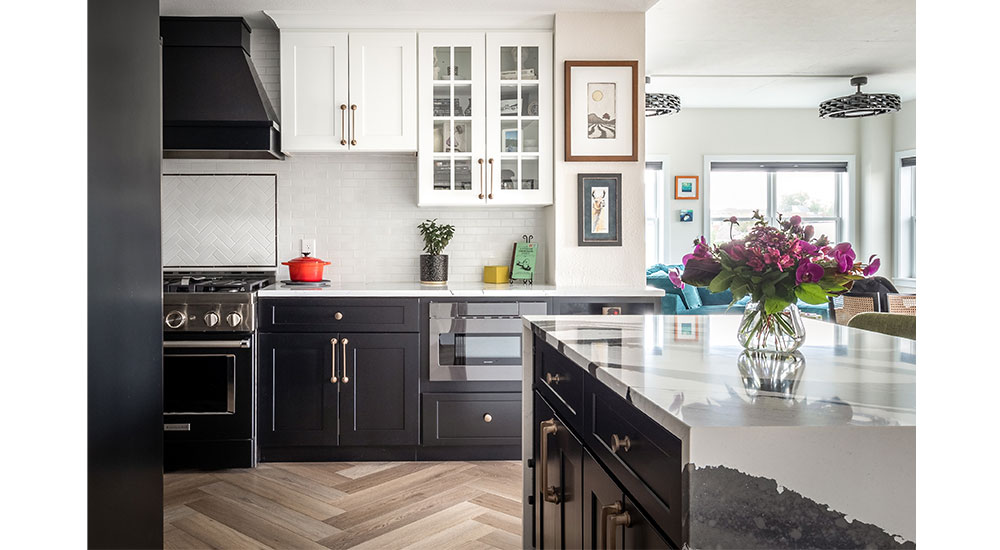If practicing interior design doesn’t already come with a world of challenges, something many seasoned designers are running into these days are buzzwords like “sustainability,” “net-zero” and “green design.” All this buzz points to the fact that eco-conscious spaces are important, but many designers who are not familiar with this niche feel left behind.
Above photo: In this kitchen, designer Megan Thompson chose low-formaldehyde cabinets that are made in the USA and KCMA certified. The flooring is FloorScore rated for indoor air quality, and the quartz is GreenGuard certified. The design team installed a two-drawer dishwasher since the clients prefer to eat out and wanted to conserve water by not running a full-size dishwasher. Photo credit: Spark Interiors
I teach sustainability to interior designers so they can confidently navigate this topic in their work. The most common question I get is how to talk to clients about accepting and even requesting sustainable spaces. It can feel daunting – albeit terrifying – if you aren’t sure whether your clients want this or if you don’t know where to start.
Let’s outline a few ways you can incorporate sustainability into the conversation with clients so it doesn’t feel like you must convince them of anything. There are some easy ways to convert change-resistant clients.
Start from the Beginning
Your onboarding practices are the first experience clients have with your business. Look over your web intake, copywriting and general messaging. Are you talking about eco-conscious interiors or healthy homes? If not, you might consider adding this to your messaging to attract the right clients from the get-go. I recommend you don’t focus too much on the message but sprinkle it in; after all, they are also looking for an excellent designer. When onboarding a new client, ask if sustainability is an important factor for this project. Their answer will reveal it all.
The reality is that clients care about different aspects of environmentally conscious design. Some may be heavily focused on reducing waste, so you can lean on reuse, refinishing and sourcing from salvage. Others may be very concerned about their carbon footprint. In that case, you can leverage sourcing from custom makers in your area.

When remodeling this bathroom, Thompson did not make layout changes, which reduces waste in construction. The cabinets are low formaldehyde, made in the USA and KCMA certified; the porcelain tile is made in North America; and all plumbing fixtures are WaterSense certified. She installed in-floor heating since this is a more efficient way to heat, with an open crawl space below to conserve energy costs for the homeowner. Photo credit: Spark Interiors
Put an Emphasis on Health
When a client does not feel that sustainability is important to their project, keep moving with the conversation. They may not know what you are talking about when all they can think about is the Pinterest board they have been creating for the last two years. It is often easiest to work another question about health and wellness into the conversation later. Nine times out of 10, a healthy selection will also be an environmentally conscious choice.
Ask if anyone in the home has sensitivities or allergies to chemicals. Or ask if they are concerned about using plastic products and finishes in their home. You may find out their son has severe asthma; in which case you can lead them toward induction cooking instead of gas. Perhaps you will learn they once lived in a home where they discovered mold, and they want to ensure that won’t happen again. This will guide your selections.
Get Buy-In for Sustainable Spaces Alternatively
If your clients are still not concerned with the health element, keep the conversation moving and get that first appointment. As you tour the project, pay attention to the food in the pantry, the makeup products on the vanity and the tags on their clothing. You may have an “in” there if they are buying organic food and animal cruelty-free makeup and wearing fair trade clothing brands. You could slip in that you work to ensure you don’t use animal-based products. Make it a connection point, not a point of contention.
If you are still coming up empty-handed, don’t despair. Ultimately, we are hired to design beautiful spaces and make the best selections for our clients. Those selections must meet the design style criteria and come in under budget. There are thousands of “green” ways to accomplish this without sacrificing your style, blowing the budget or shaking your clients’ confidence. In other words, so long as your clients are happy, you have done your job.
That’s not to say you shouldn’t tell them when you find something fabulous and environmentally conscious. It can be helpful to let them know that a selection is more cost-effective and longer lasting. Even if you think they don’t care, you have just educated them.
By Megan Thompson, Founder of Interior Design greenList & Spark Interiors









